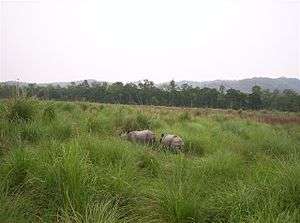Terai-Duar savanna and grasslands
| Terai-Duar savanna and grasslands | |
|---|---|
|
Rhinoceros unicornis in Chitwan National Park, Nepal | |
| Ecology | |
| Biome | Tropical and subtropical grasslands, savannas, and shrublands |
| Borders | |
| Bird species | 366[1] |
| Mammal species | 115[1] |
| Geography | |
| Area | 34,600 km2 (13,400 sq mi) |
| Countries | India, Nepal and Bhutan |
| Conservation | |
| Habitat loss | 90.62%[1] |
| Protected | 8.91%[1] |
The Terai-Duar savanna and grasslands is a narrow lowland ecoregion at the base of the Himalayas, about 25 km (16 mi) wide, and a continuation of the Gangetic Plain. It is colloquially called Terai in the Ganges Basin east to Nepal, then Dooars in West Bengal, Bangladesh, Bhutan and Assam east to the Brahmaputra River. The world's tallest grasslands are found in this ecoregion, which are the most threatened and rare worldwide.[2]
Location and description
This tropical and subtropical grasslands, savannas, and shrublands biome stretches from western Bhutan to southern Nepal's Terai, westward to Banke, covering the Dang and Deukhuri Valleys along the Rapti River to India's Bhabar and Doon Valleys. Each end crosses the border into India's states of Uttar Pradesh and Bihar.[2] The eastern and central areas are wetter than the western end.
In Nepal, the wetlands of Koshi Tappu Wildlife Reserve, Beeshazar Tal in the bufferzone of Chitwan National Park, Jagdishpur Reservoir and Ghodaghodi Tal are designated Ramsar sites.[3] The Sukla Phanta Wildlife Reserve is Nepal's largest patch of continuous grassland.[4]
Flora
The Terai-Duar savanna and grasslands are a mosaic of tall riverside grasslands, savannas and evergreen and deciduous forests, depending on soil quality and the amount of rain each area receives. The grasslands of the Terai in Nepal are among the tallest in the world, and are maintained by silt deposited by the yearly monsoon floods. Important grasses include baruwa and kans grass (Saccharum spontaneum), which quickly establishes itself after the retreat of the monsoon waters. In the hillier areas the dominant tree is sal (Shorea robusta), which can grow to a height of 45 m (148 ft). The belt also contains riverside tropical deciduous forest comprising Mallotus philippensis, jamun, cotton tree, Trewia nudiflora, and Garuga pinnata.[2]
Fauna
The ecoregion is habitat for a huge number of mammalian and bird species.[1] Notable are the large numbers of the endangered greater one-horned rhinoceros and Bengal tigers as well as Asian elephants, sloth bears, Indian leopards.
In Nepal's Chitwan National Park, more than 400 rhinos were sighted in 2008, and 125 adult tigers were recorded during a survey conducted from December 2009 to March 2010, which covered an area of 1,261 km2 (487 sq mi).[5][6] Nepal's Bardia National Park and Sukla Phanta Wildlife Reserve, and India's Valmiki and Dudhwa National Parks are home to nearly 100 tigers. Chitwan along with the adjoining Parsa Wildlife Reserve is of major importance, especially for tigers and clouded leopard. Grazing animals of the grasslands include five species of deer, barasingha, sambar, chital, hog deer and muntjac along with four large grazing animals, Asian elephant, rhinoceros, gaur and nilgai. Endangered mammals found here include the wild water buffalo and the near-endemic hispid hare (Caprolagus hispidus).
The grasslands are also home to a number of reptiles including the gharial, mugger crocodile and soft-shelled turtles.
The grasslands partly cover two BirdLife International Endemic Bird Areas, the Central Himalayas EBA in western Nepal and the western end of the Assam Plains EBA south of Bhutan. There are three near-endemic bird species including the vulnerable Manipur bush quail (Perdicula manipurensis). The 44 threatened and declining bird species of the grasslands include the Bengal florican (Houbaropsis bengalensis), lesser florican (Sypheotides indica), sarus crane (Grus antigone) and rufous-rumped grassbird (Graminicola bengalensis).
Threats and conservation
Although the population density has been low it is now growing, especially in the southern Terai belt and much of the ecoregion has been converted to farmland since the forest was cut down for timber, although Sukla Phanta Wildlife Reserve, Chitwan, Bardia and Dudhwa National Parks, some of which were once royal hunting grounds, preserve significant sections of habitat, and are home to some of the greatest concentrations of rhinoceros and tiger remaining in South Asia. The areas of tall grasslands, which in particular have been much reduced for farmland, are of special conservation importance. The remaining forest meanwhile is mostly found in the drier bhabar belt, with some forest patches in Chitwan National Park.
See also
References
- 1 2 3 4 5 Hoekstra, J. M., Molnar, J. L., Jennings, M., Revenga, C., Spalding, M. D., Boucher, T. M., Robertson, J. C., Heibel, T. J., Ellison, K. (2010). Molnar, J. L., ed. The Atlas of Global Conservation: Changes, Challenges, and Opportunities to Make a Difference. University of California Press. ISBN 978-0-520-26256-0.
- 1 2 3 Dinerstein, E., Loucks, C. (2001). "Terai-Duar savanna and grasslands". Terrestrial Ecoregions. World Wildlife Fund.
- ↑ Bhandari, B.B. (2009) Wise use of Wetlands in Nepal Banko Janakari, Special Issue February 2009: 10-17 pdf
- ↑ Baral, H.S., Inskipp, C. (2009) The Birds of Sukla Phanta Wildlife Reserve, Nepal. Our Nature (2009) 7: 56-81
- ↑ Basu P. (2008). Rare One-Horned Rhino Bouncing Back in Nepal. National Geographic News article online
- ↑ WWF Nepal (2010) More tigers found in Nepal as Nepal-India trans-boundary efforts for tiger conservation intensify article online
External links
- WWF: Map of ecoregions in Nepal, showing the Terai-Duar savanna and grasslands
- The Ramsar Convention on Wetlands: The Annotated Ramsar List of Nepal
